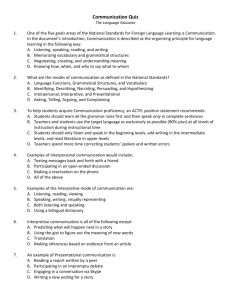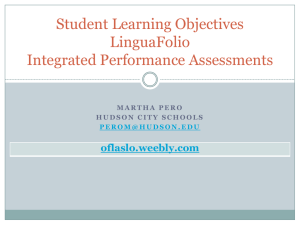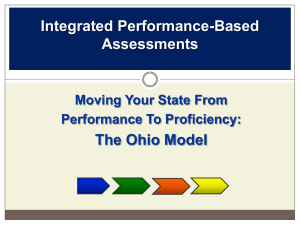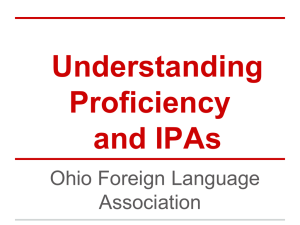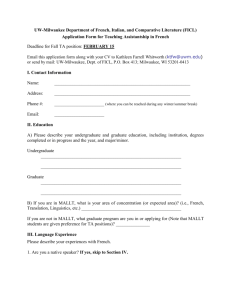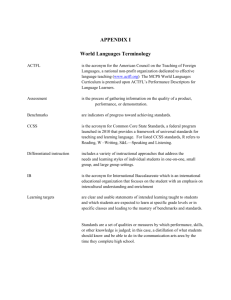Power Point template for creating your 3
advertisement
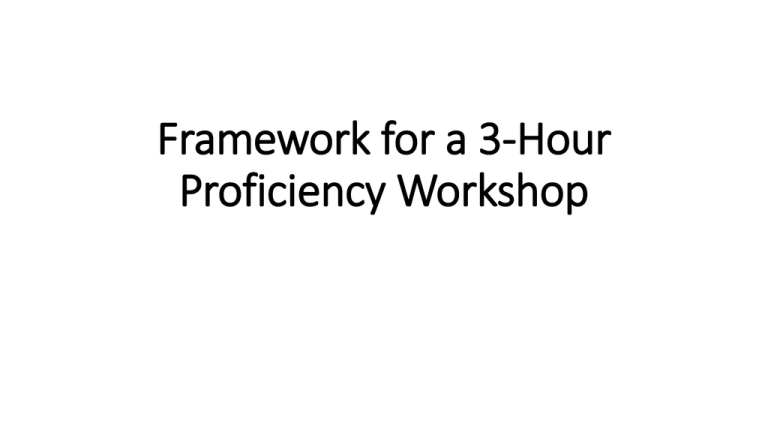
Framework for a 3-Hour Proficiency Workshop NOTE to Presenter: • Slides # 3 – 8 are notes on how to present your workshop. • These slides wouldn’t be included in your presentation • Location of Workshop Documents: http://oflaslo.weebly.com/moving-your-state-from-performanceto-proficiency-the-ohio-model.html Ideas For Moving Your State From Performance to Proficiency 1. OFLA and ODE work closely together so that there is a consistent message. 2. Vertical alignment in your building, district and state is a must. 3. We used our Ohio Teacher Evaluation System (OTES) to drive the instructional shift. We took the lead and gave input into how our world language teachers would be evaluated. 4. The ODE Model Curriculum and the OFLA Weebly provide current and effective resources for our teachers: IPA samples, authentic resources, rubrics, Can-Do checklists, instructional and assessment tools, websites for language learners, and other resources. Ideas For Organizing Workshops 5. We use the OFLA listserv and ODE announcements to organize workshops, spread the message, share ideas and answer questions. 6. We created a cohort of teachers that were trained to lead workshops on proficiency, modes of communication, and performance-based assessments. 7. We led (and continue to lead) workshops around the state to get teachers on board, including at the OFLA state conference. 8. ODE and OFLA continue to offer free or low-cost professional development around the state, for teachers who want to learn even more! Additional Suggestions 9. For districts that only have 1 or 2 world language teachers, or are isolated from collaboration with other colleagues: • We encourage these teachers to form Professional Learning Networks for support and collaboration. • These teachers collaborate via Facebook Groups; Google Hangouts or Google Docs; email groups; periodic meetings for face-to-face collaboration, discussions, or guest speakers. How Do I Run My Workshop? The Central States workshop was similar to how we run our Ohio workshops. a) We incorporate continuous teacher input, sharing and discussion during the workshop. This allows teachers to see that they are already doing a lot of proficiency-based instruction and assessment in their classrooms. b) We provide concrete examples for everything we talk about. c) We share numerous resources that are already available online, to show teachers that they don’t have to start from scratch. d) We encourage teachers to incorporate this at a pace that works for them. It may take several years to implement everything that they want to implement and to develop a repertoire of resources. NOTE to Presenter: • The rest of this Power Point is the framework for your workshop presentation! Integrated Performance-Based Assessments Moving Your State From Performance to Proficiency Your Contact Information Agenda 1. 2. 3. 4. 5. 6. Online resources for today’s workshop (Your state)’s World language standards Performance vs Proficiency ACTFL proficiency levels Using Can-Do statements to guide instruction IPAs, authentic cultural resources and task creation 7. Rubrics Goals of this workshop 1. Summarize our state standards and the difference between performance and proficiency. 2. Clarify the What, the Why, the When and the How of performance-based instruction and assessment. 3. Specify available resources for instruction and assessment, as well as tools to help educators understand the ACTFL proficiency levels. 4. Learn how to gradually integrate these tools into what teachers are already doing so that teachers don’t have to reinvent the wheel. Helpful Websites (add web links that you feel will be helpful to teachers in your state) • Ohio’s World Language Model Curriculum: http://education.ohio.gov/ (search box: World Language Model Curriculum) • Ohio Foreign Language Association weebly: http://oflaslo.weebly.com/ • ACTFL http://www.actfl.org/ (Your state)’s World Language Standards (Prior Knowledge: Ask what they already know about your state standards) (Your state)’s World Language Standards Provide an outline or summary of your state’s World Language standards Three Modes of Communication: a) Interpretive: reading, listening, viewing Comprehension of a video, audio or text through reading, listening to, or viewing the source. b) Interpersonal: speaking/listening; writing/reading Interaction with others via oral, written or signed conversations. Negotiation of meaning, exchange of opinions or information. c) Presentational: writing, speaking, signing Delivering information via speaking, writing or signing, in prepared or spontaneous presentations. 90% Target Language Group Prior Knowledge: How do you use TL in your classroom? What are your challenges?, etc. Use of the Target Language • Provide or Brainstorm strategies for staying in the target language • See ODE Model Curriculum “Instructional Strategies” for TL strategies http://education.ohio.gov/Topics/Ohio-s-New-Learning-Standards/Foreign-Language/World-LanguagesModel-Curriculum/World-Languages-Model-Curriculum-Framework/Instructional-Strategies Performance vs Proficiency • Group Prior Knowledge: what do they think is the difference? • What do they already know about this, etc? Performance vs. Proficiency Performance vs. Proficiency • Performance levels may be higher than Proficiency levels: • Example: A student may be at Intermediate Low on a unit assessment that they just practiced. (Performance) • In a spontaneous situation, the same student may now only be at a Novice High. (Proficiency) Importance of Communicative Proficiency Provide notes or group brainstorm why it’s important for students to be proficient in the language, vs just knowing grammar or vocab. ACTFL Proficiency Levels • Group Prior Knowledge: ask what they already know about ACTFL and proficiency levels, etc. ACTFL Proficiency Levels The ACTFL Proficiency Guidelines The ACTFL Proficiency Guidelines and Levels: http://actflproficiencyguidelines2012.org/ • refer to real-world, authentic situations in a spontaneous and non-rehearsed context. • evaluate sustained, functional language ability, regardless of where, when or how the language was acquired. • describe what individuals can do with language in terms of speaking, writing, listening, and reading. The ACTFL Proficiency Guidelines The ACTFL Proficiency Guidelines and Levels: http://actflproficiencyguidelines2012.org/ • Print the ACTFL pyramid (8.5 x 11, or 11 x 17). • Download the proficiency guidelines, by skill and level. • View writing and speaking samples of each proficiency level, in many languages. ACTFL Proficiency Levels Defined NCSSFL-ACTFL Can-Do Statements • Group Prior Knowledge: ask what they already know about the CanDo statements, do they use them, etc. NCSSFL-ACTFL Can-Do Statements 1. The new 2013 Can-Do statements are aligned to the ACTFL Proficiency Levels, in student-friendly language. 2. They give concrete examples of what students should be able to do in reading, writing, listening, speaking, and interpersonal skills at each proficiency level. 3. The Can-Do statements are a good reference tool for teachers, parents and administrators, to help clarify what proficiency in a language looks like and to show the expectations for the class. NCSSFL-ACTFL Can-Do Statements 1. The NCSSFL-ACTFL Can-Do checklists are available in the ODE Model Curriculum (under “Expectations for Learning”). 2. Can-Do statements are also found on the ACTFL website under “Publications”. Backward Design • Group Prior Knowledge: ask what they already know about Backward Design, why is it important, etc. Designing an IPA, Unit or Course Backward Design (Wiggins and McTighe): 1. Identify desired results: Performance target, communicative and cultural goals 2. Determine acceptable evidence: Performance-based assessment 3. Plan learning experiences and instruction: Instructional activities, authentic resources and content IPAs – Integrated Performance Assessments • Group Prior Knowledge: ask what they already know about IPAs, do they use performance-based assessments, etc. What is an IPA? An IPA is a multi-task assessment framework designed by ACTFL. Integrated Tasks Within A Common Theme Three Parts of an IPA • Explain the 3 parts of an IPA. For help: The ODE Model Curriculum has detailed information about IPAs http://education.ohio.gov/Topics/Ohio-s-New-Learning-Standards/Foreign-Language/WorldLanguages-Model-Curriculum/World-Languages-Model-Curriculum-Framework/InstructionalStrategies#strategies2 Where Can I Find Sample IPAs? (include other links where they can find IPAs) • ODE World Languages Model Curriculum Instructional Strategies Unit Samples • OFLA Weebly site: oflaslo.weebly.com : Under second tab at the top: “IPA Center” • OFLA Technology IPAs: Livebinders.com OFLA IPA Tech Integration Designing an IPA and Unit Provide a sample IPA template for teachers to refer to as you go over the components of designing an IPA. Why use an IPA? Provide or brainstorm ideas as to why an IPA is beneficial What Type of Tasks are in an IPA? Provide or brainstorm ideas as to how teachers can create IPA tasks that involve higher-level thinking skills. Provide or brainstorm how to create open-ended tasks with “Stretch” so all students can succeed. Provide or brainstorm tasks that are real-world and appropriate for different levels of learners. Interpretive Mode of Communication • Group Prior Knowledge: ask what students should be able to do in interpretive tasks, in reading, writing, etc. Interpretive Communication Developing Interpretive Tasks Using the ACTFL template - Appendix D Provide a copy, or link to, the ACTFL Appendix D for creating interpretive tasks that encourage higher level thinking skills. Go over the components of Appendix D together, and which parts might be used with which level of students. A pdf of Appendix D is found in Ohio’s Model Curriculum: http://education.ohio.gov/Topics/Ohio-s-New-Learning-Standards/Foreign-Language/World-Languages-ModelCurriculum/World-Languages-Model-Curriculum-Framework/Instructional-Strategies/Assessment-Guidanceand-Sample-Rubrics ACTFL Rubric for scoring Interpretive Tasks Appendix F Provide a copy, or link to, the ACTFL Appendix F for creating interpretive tasks that encourage higher level thinking skills. Explain how Appendix F aligns to Appendix D, for any level student. A PDF of Appendix F is found in Ohio’s Model Curriculum: http://education.ohio.gov/Topics/Ohio-s-New-Learning-Standards/Foreign-Language/World-Languages-ModelCurriculum/World-Languages-Model-Curriculum-Framework/Instructional-Strategies/Assessment-Guidanceand-Sample-Rubrics Sample Interpretive Activities • Provide your participants with actual Interpretive Reading and Listening activities that you have done with your students in your classroom. • Ask participants to share ideas for activities that they have done. Authentic Cultural Resources • Group Prior Knowledge: ask what makes a resource authentic, what are benefits of using authentic resources, etc What is “Culture” ? • Products (the What): • • monuments, laws, music, etc. Practices (the How): • • eating or shopping habits, use of space, etc. Perspectives (the Why): • values, attitudes, beliefs, etc. How Can I Embed Culture Into My Lessons? • Provide or link to the NCSSFL intercultural Can-Do statements: http://education.ohio.gov/Topics/Ohio-s-New-Learning-Standards/ForeignLanguage/World-Languages-Model-Curriculum/World-Languages-Model-CurriculumFramework/Expectations-for-Learning • Look at the culture Can-Dos together, discuss how teachers and students can use them, etc. • Brainstorm ways to embed culture into lessons, instead of making it a separate piece of the curriculum What is an Authentic Resource? • An audio, video, or text made by native speakers for native speakers. • It gives a distinct native perspective of the target culture and its people by providing a real-life experience of the products and practices of that culture. • An authentic resource has not been modified or simplified for language learners.* *Many textbook resources have been modified or simplified. What Type of Authentic Resource Should I Use? Discuss / brainstorm appropriate types of authentic resources for different levels of students. Discuss what makes an effective or useful authentic resource. Where Can I Find Authentic Resources? (Include other links that you use) • Ohio Department of Education Model Curriculum for World Languages: Instructional and Authentic Resources • FLTeach: http://web.cortland.edu/flteach/flteach-res.html • Youtube. Google images. Google (.fr / .es/ .de / etc.) • GROUP SHARING of websites they use for authentic resources Interpersonal Mode of Communication • Group Prior Knowledge: ask what students should be able to do in interpersonal conversations, oral or written, share ideas, etc. Interpersonal Communication Sample Interpersonal Activities • Provide your participants with actual Interpersonal activities that you have done with your students in your classroom. • Ask participants to share ideas for activities that they have done. Logistics for Assessing Interpersonal Speaking How do I keep the other students busy while I’m assessing? Group sharing of strategies for organizing and assessing interpersonal activities for an IPA. Presentational Mode of Communication • Group Prior Knowledge: ask what students should be able to do in oral or written speech, share ideas, etc. Presentational Communication Sample Presentational Activities • Provide your participants with actual Presentational speaking and writing activities that you have done with your students in your classroom. • Ask participants to share ideas for activities that they have done. Benefits of IPAs • Discuss as a group the benefits of IPAs or other Performance-based assessments, as opposed to multiple choice or vocab and grammar tests. IPA sample Provide participants with a sample of an IPA that you created and used with your students in your classroom. Talk about how you developed it, share samples of student work from the IPA, etc. Brainstorm how this IPA could be “stretched” to be used with other levels of learners (higher or lower levels) Whole Group Creation of an IPA • Provide participants with an authentic resource in another language (e.g., weather map, school schedule, clothing catalog, etc.) • As a group, brainstorm the tasks that you could develop, to make an IPA from this resource. • Stress how creating an IPA can be collaborative despite different languages. Everyone finds a similar resource in their target language, then works together to make up the IPA tasks. Small group - IPA creation • If you have time, give participants a blank IPA template and break them into small groups. • Have them create the tasks for an end-of-unit IPA based on a theme or topic that they cover in their curriculum. • Share the IPAs with the whole group. Rubrics • Group Prior Knowledge: ask if they already use rubrics, what are the benefits, challenges, etc. Rubrics • Define for participants the components of an analytic (performance) rubric and a holistic (proficiency) rubric. • Share samples of each type of rubric. • For help, Ohio’s model curriculum has information about rubrics and sample rubrics: • http://education.ohio.gov/Topics/Ohio-s-New-Learning-Standards/Foreign-Language/World-LanguagesModel-Curriculum/World-Languages-Model-Curriculum-Framework/Instructional-Strategies References • Adair, Glisan, Troyan. Implementing Integrated Performance Assessments. American Council on the Teaching of Foreign Languages, 2013 • Sandrock, Paul. The Keys to Assessing Language Performance: A Teacher's Manual for Measuring Student Progress. American Council on the Teaching of Foreign Languages, 2010 • American Council on the Teaching of Foreign Languages, 2015. www.actfl.org • Battelle for Kids, 2015. FIP Your School Ohio. http://portal.battelleforkids.org/FIPOhio • Kentucky Department of Education, 2015. http://education.ky.gov/curriculum/wlang • National Council of State Supervisors for Languages, 2015. www.ncssfl.org • OFLA Weebly, 2015. http://oflaslo.weebly.com • Ohio Department of Education, 2015: http://education.ohio.gov • Ohio Foreign Language Association, 2015. http://www.ofla-online.org/
